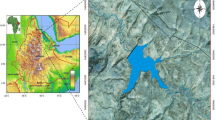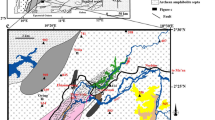Summary
This paper is concerned with the geological investigations of a projected 140 m high double-curvature arch dam in the Pindos Range in Central Greece which will eventually be the uppermost of a cascade of six dams on the Acheloos River for the generation of hydro-electric power. It is situated where the river cuts through a ridge composed mainly of limestones. Five lithological zones are distinguished at the site, that in the foundation area consisting of fine grained limestones with subordinate chert, in beds 10 cm to 20 cm thick, with an average of 6 per cent of shale in thin partings. The dip is generally at 60° upstream. A feature of the subsurface investigations was the unusually extensive use of exploratory adits. There were many advantages in this. Not only could geological structures be traced underground with accuracy but a range of rock mechanics tests and geophysical survey work could also be carried out actually at the proposed foundation level and beneath the weathered zone. Some test results are presented, among other things confirming the visual impression that the modulus of deformation decreases with increasing elevation. The orientation of several hundred joints was measured and four main sets identified from stereographic plots of the data. Concern caused by the combination of a set dipping downstream and a near-vertical stress relief set parallel to the gorge was dispelled by the results from four in situ shear tests.
As a result of the investigations the initial desgin of the dam was modified in several respects, the most important and unfortunate of which was a reduction in height from 185 m to 140 m, enforced by adverse geological and topographical conditions.
Résumé
Cette étude concerne un projet de barrage-voûte de 140 m de haut à construire dans la chaîne du Pinde (Grèce centrale). Il doit être le plus élevé d'une série de cinq barrages destinés à l'exploitation hydro-électrique du fleuve Achéoos. Il est situé à un endroit où le fleuve coupe une arête composée principalement de calcaires. On reconnaît au site cinq zones lithologiques, dont celle proposée pour les fondations est composée de calcaires à texture fine avec silex subsidiaire, en lits de 10 à 20 cm d'épaisseur avec une moyenne de 5% de schistes en couches très minces. Le pendage est généralement de 60° vers l'amont. Un aspect exceptionnel des études du sous-sol a été l'usage considérable de tunnels d'exploration. Il en est résulté de nombreux avantages. Non seulement on a pu tracer avec précision les structures géologiques du sous-sol mais aussi il a été possible d'effectuer précisément au niveau proposé pour les fondations et sous la zone altérée par les intempéries une série d'essais de mécanique des roches et des mesures géophysiques. Quelques résultats d'essais sont présentés ci-dessous, confirmant entre autres l'impression visuelle que le module de déformation diminue à mesure que l'élévation augmente. L'orientation de plusieurs centaines de joints a été mesurée et quatre ensembles principaux ont été établis d'après les tracés stéréographiques des données. L'inquiétude occasionnée par un ensemble s'inclinant en aval et un ensemble presque vertical parallèle à la gorge a été dissipée par les résultats de quatre épreuves de cisaillement. Par suite de ces recherches le dessin initial du barrage a été modifié à plusieurs points de vue, dont le plus important et le plus regrettable a été la réduction de la hauteur de 185 m à 140 m, nécessitée par des conditions géologiques et topographiques défavorables.
Similar content being viewed by others
References
AUBOUIN J. (1959): Contribution à l'Étude Géologique de la Grèce Septentrionale, les Confins de l'Épire et de la Théssalie. Ann. Géol. des Pays Héllènes, X, 525 pp.
BARBIER R. (1967): Rapport Géologique Préliminaire sur les Projets de Barrage de Messochora et de Saint Georges. Report to PPC.
BRUNN J.H. (1956): Étude Géologique du Pinde Septentrional et de la Macédoine Occidentale. Thèse, Paris, Ann. Géol. des Pays Héllènes, 7, 358 pp.
DEERE D.U. (1971): Technical Letter D-268, No. 4, “Messochora Damsite.” Report to Public Power Corporation of Greece, 8 pp. (unpublished).
DEERE D.U.—NIETO-PESCETTO A. (1972): Abutment Stability Analyses for the Messochora Arch Dam, Report to the Public Power Corporation of Greece 10 pp. (unpublished).
KALLERGIS G. (1966): Geological Conditions of the Messochora site, ibid. Athens, Report to PPC.
MEIDAV T. (1966): Dynamic Testing of Soil with the Seismic Method. Huntec Limited, Toronto, Canada.
STAGG C.G.—ZIENKIEWICZ O.C. (1968) Rock Mechanics in Engineering Practice, pp. 227–231, John Wiley and Sons Ltd., London.
Author information
Authors and Affiliations
Rights and permissions
About this article
Cite this article
Hunt, B.N.F. The investigation of messochora dam site. Bulletin of the International Association of Engineering Geology 19, 176–182 (1979). https://doi.org/10.1007/BF02600472
Published:
Issue Date:
DOI: https://doi.org/10.1007/BF02600472




